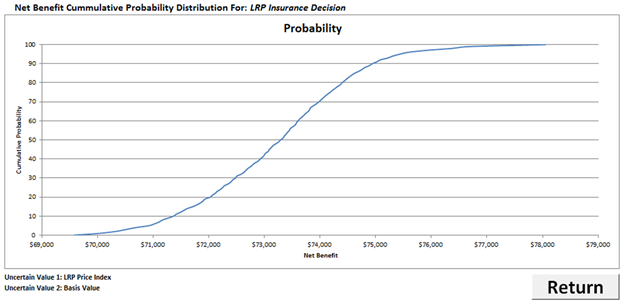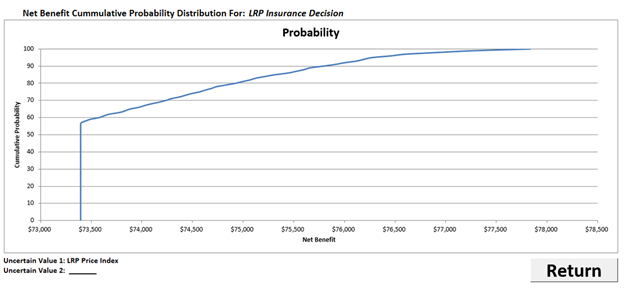 |
February 2017
|
February 2017 // Volume 55 // Number 1 // Tools of the Trade // v55-1tt7
Risk Scenario Planning Tool for Education on Livestock Risk Protection Insurance for Feeder Cattle
Abstract
It can be difficult to provide livestock producers with effective education on livestock risk protection (LRP) insurance. Recently, the RightRisk Education Team developed a risk scenario planning tool that applies a partial budget analysis approach to decision making under uncertainty. A case study for use with the tool was developed for educating producers about the U.S. Department of Agriculture Risk Management Agency's Livestock Risk Protection Insurance Plan for Feeder Cattle. We have found the combination of the tool and case study to be effective in developing producers' understanding of LRP insurance to a level at which they feel comfortable analyzing the decision of whether to purchase the insurance.
Introduction
The U.S. Department of Agriculture Risk Management Agency introduced the Livestock Risk Protection Insurance Plan for Feeder Cattle (LRP-Feeder Cattle) in 2003 as a single-peril price risk insurance that provides an indemnity to insured producers should a national feeder cattle price index be below a selected coverage price on the end date of the insurance policy. LRP-Feeder Cattle essentially functions like a put option for the producer in that it establishes a floor for the national selling price for feeder cattle at a particular point in the future while still allowing the producer to benefit from price increases.
Building an Extension education program on futures and options can be difficult. Although beef producers cite cattle price variability as one of their top risk concerns, they indicate a preference for attending educational programs that focus on production or herd health (Hall, Knight, Coble, Baquet, & Patrick, 2003). On the other hand, producers indicate that their limited use of futures and options is mostly a result of a lack of understanding of the market institutions in which they function (Small, Waterbury, & Mark, 2008). Given this situation, it can be difficult to provide producers with effective education on livestock risk protection (LRP) insurance.
The RightRisk Education Team, of which we are part, is a group of researchers and Extension specialists who provide risk management information to ranchers and farmers. We have developed a library of materials to help educate producers about LRP-Feeder Cattle. These materials are available at RightRisk.org and include Ag Survivor simulation scenarios, online course materials, and presentation slides.
Recently, we developed a risk scenario planning tool that allows a producer to apply a partial budget analysis approach to decision making under uncertainty. A key to this approach is that it focuses the producer's attention on the effects of the specific change he or she is considering making (Hanson, Parsons, Chess, & Balliet, 2002). We have found this approach to be useful in developing producers' understanding of LRP insurance to a level at which they feel comfortable analyzing the decision of whether or not to purchase the insurance.
Tool Description
To educate producers on the LRP-Feeder Cattle decision, we developed a case study for use with the risk scenario planning tool. The case study, which is fully described in the Risk Scenario Planning Technical Guide (Parsons & Hewlett, 2013), considers the purchase of LRP-Feeder Cattle on 100 head of 500-lb calves. In performing a typical partial budget analysis, the tool addresses the four traditional categories: added returns, added costs, reduced costs, and reduced returns. The LRP-Feeder Cattle decision involves added returns in the form of potential indemnity payments and added costs in the form of insurance premiums. However, we have found that also including sales revenues in the added returns section of the partial budget is useful for encouraging producers to think about protecting income instead of just trying to profit from the insurance. Figure 1 shows values from the case study entered into the risk scenario planning tool interface.
Figure 1.
Completed Partial Budget Analysis for Purchasing LRP-Feeder Cattle
Lines 1 and 2 in the added returns section of the partial budget are used for the uncertain basis value and the yet-to-be-determined actual ending value for the LRP-Feeder Cattle price index. On line 3 is the data input for the LRP coverage price under consideration.
Also on the positive side of the ledger are two sources of revenue. Sales revenue from selling calves in the cash market is calculated on line 5. The cash market price is a calculated value equal to the LRP price index value minus the basis value. The other source of revenue, calculated on line 6, is an LRP insurance indemnity payment that will occur if the LRP price index ends at a value that is less than the LRP coverage price.
On the negative side of the ledger, on line 1 in the added cost section, the added cost of the LRP insurance policy premium is calculated on the basis of the producer premium rate of $3.68 per cwt.
Producers purchase LRP-Feeder Cattle because of the protection it provides when they are worried about possible price declines. The risk scenario planning tool allows for uncertainty to be incorporated into any two cells, as demonstrated in Figure 2.
Figure 2.
Sample Risk Scenario for the LRP-Feeder Cattle Decision
To address a possible risk scenario for the LRP-Feeder Cattle decision, two uncertain values are entered into the tool interface. Uncertain value 1 is the LRP price index value in cell D7. The currently expected LRP price index value of $160.99 (see Figure 1) is entered as the current/most likely value for this variable, $140 is entered as a minimum possible value, and $170 is entered as a maximum possible value. These values are used to create a beta distribution of possible actual ending values of the LRP price index.
Uncertain value 2 is the basis value in cell D6. The currently expected basis value of $10.00 (see Figure 1) is entered as the current/most likely value for this variable, $5 is entered as a minimum possible value, and $20 is entered as a maximum possible value.
Results
When the user clicks the "Run" button, the tool performs an analysis based on the specified risk scenario involving the two uncertain variables. The results are shown in a cumulative distribution graph (Figure 3). To display individual data points, the user mouses over the points on the graph. The graph can be used as a basis for discussing the range of possibilities as well as the probability of achieving a particular threshold of net revenue (i.e., revenue equal to cost of production). To display a true floor, the user returns to the data entry screen, omits the basis uncertainty, and clicks "Run" again (Figure 4). To display an analysis of the risk without the insurance, the user enters zero for the quantity on the indemnity calculation and on the premium calculation.
Figure 3.
Distribution of Results from Uncertainty Introduced into the LRP-Feeder Cattle Decision

Figure 4.
Distribution of Results of the LRP-Feeder Cattle Decision without Basis Value Uncertainty

Feedback collected from audiences attending workshops at which this tool was demonstrated has indicated 94% agreement among participants that the tool was useful to them and 70% agreement that they would apply something they learned while using the tool in future decision making.
Summary
We have found the risk scenario planning tool with the LRP-Feeder Cattle case study to be very effective in providing producers with a hands-on learning experience that leads to increased understanding of this insurance decision.
References
Hall, D. C., Knight, T. O., Coble, K. H., Baquet, A. E., & Patrick, G. F. (2003). Analysis of beef producers' risk management perceptions and desire for further risk management education. Review of Agricultural Economics, 25(2) (December 2003), 430–448.
Hanson, G. D., Parsons, R. L., Chess, W. J., & Balliet, K. L. (2002). Farm production analysis training for small farmers. Journal of Extension, 40(4) Article 4FEA8. Available at: https://www.joe.org/joe/2002august/a8.php
Parsons, J., & Hewlett, J. P. (2013). Risk scenario planning. RightRisk Education Team Technical Guide #TG-13-08. Retrieved from http://www.rightrisk.org/tools/2013_08_RiskScenarioPlanning_TG-ModC.pdf
Small, R. M., Waterbury, J. A., & Mark, D. R. (2008). Livestock insurance web site: A learning tool for producers, insurance agents, and educators. Journal of Extension, 46(3) Article 3TOT4. Available at: https://www.joe.org/joe/2008june/tt4.php




